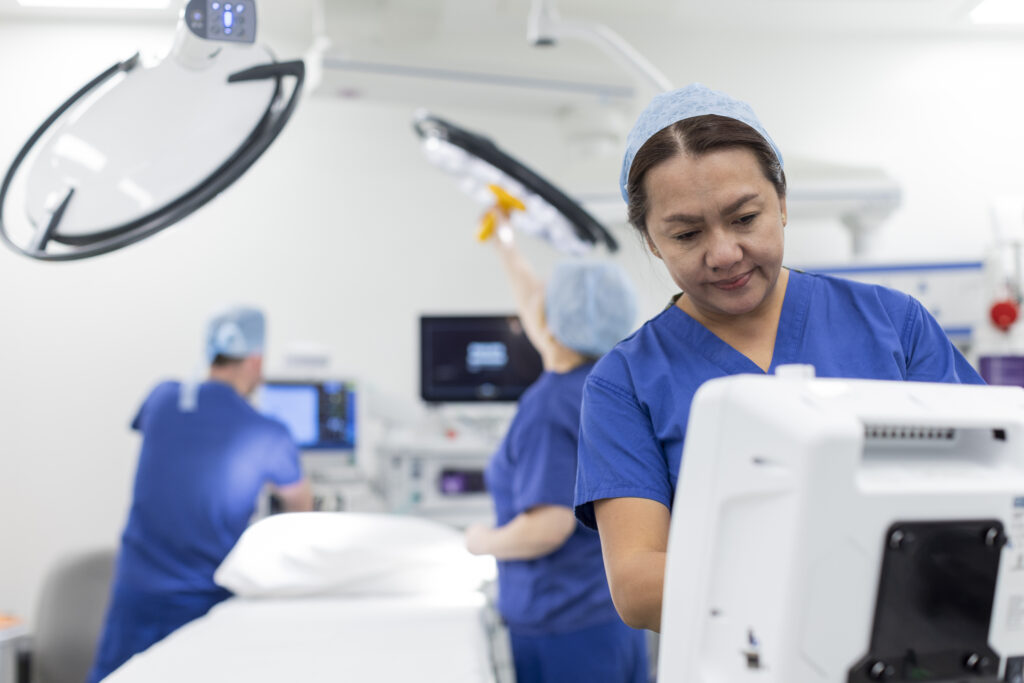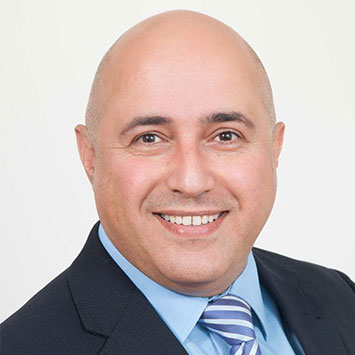What is prostatic urethral lift?
The prostatic urethral lift (PUL), commonly known as the UroLift System, is a minimally invasive treatment for benign prostatic hyperplasia (BPH) – a condition in which the prostate gland becomes enlarged, pressing against the urethra and making urination difficult or uncomfortable. Unlike traditional surgeries that involve cutting, heating, or removing prostate tissue, the UroLift system uses tiny permanent implants to gently lift and hold the enlarged parts of the prostate away from the urethra.
Benefits of the prostatic urethral lift
Because the procedure doesn’t involve cutting or heating tissue, it’s considered safer and less invasive than traditional surgeries like transurethral resection of the prostate (TURP). The procedure is typically performed in a urologist’s office or outpatient setting under local anaesthesia, and most patients are discharged the same day, often without needing a catheter afterwards.
One of the most significant advantages of the UroLift procedure is the rapid relief of urinary symptoms. Many patients notice an improvement in urine flow, reduced urgency, and fewer nighttime bathroom trips within just a few days. Another key benefit is that sexual function is preserved, particularly ejaculation. This is an essential consideration for many men when comparing BPH treatment options, as other surgeries may carry a risk of sexual side effects.
Recovery time is short, and many men can return to work and normal activities within a few days, compared to the more extended recovery periods required for procedures like TURP or HoLEP.
Who is a candidate for prostatic urethral lift?
You might be a good candidate for the UroLift procedure if you’re experiencing bothersome urinary symptoms related to BPH, such as frequent urination, weak urine stream, trouble starting or stopping urination, or a constant urge to go. UroLift is especially helpful for men who haven’t had good results with BPH medications or have experienced side effects from those drugs.
Your eligibility for the UroLift procedure is determined by a urologist, who will conduct a comprehensive evaluation to assess your suitability. The UroLift system is not suitable for everyone. Men with very large prostates or specific anatomical differences may need other treatment options. The urologist will explain all available alternatives if UroLift isn’t the best fit.
Please call to enquire about the price
Ways to payBefore the procedure
Initial consultation
Your journey starts with an initial consultation. During this appointment, your urologist will carefully review your symptoms and medical history, conduct a physical examination, and may recommend diagnostic tests to better understand your condition. These may include a urine flow test, ultrasound, or cystoscopy to examine the inside of your bladder and urethra.
Preparing for the procedure
In the days leading up to your UroLift procedure, your doctor may ask you to stop drinking alcohol and caffeinated beverages at least 48 hours before treatment. Be sure to let the medical team know about all medications or supplements you’re taking to avoid potential interactions. Some patients may be prescribed antibiotics to take the day before the procedure to reduce the risk of infection. Following these simple instructions helps ensure the treatment goes smoothly and sets you up for a quick recovery.
During the procedure
The prostatic urethral lift is typically performed in a clinic or outpatient setting using local anaesthesia, which numbs the area while keeping you awake and comfortable. You’ll lie on your back with your legs supported, and the procedure usually takes around 15 minutes.
Using a thin instrument inserted through the urethra, the doctor places tiny permanent implants into the prostate. These implants lift the enlarged tissue away from the urethra, opening the channel and relieving obstruction. Because there’s no cutting, heating, or removal of tissue, the procedure is considered very safe and minimally invasive.
Thanks to the local anaesthesia and lack of surgical trauma, most patients experience minimal discomfort and can go home the same day.
After the procedure
Recovery from UroLift is typically fast and straightforward. Some minor side effects are regular and temporary. These might include a small amount of blood in the urine, mild burning when urinating, or a sensation of increased sensitivity in the penis. These usually go away on their own within a few days.
Staying hydrated by drinking 1.5 to 2 litres of water daily can help flush the bladder and accelerate healing. Light activity can be resumed soon after the procedure; however, you should avoid heavy lifting or strenuous exercise for approximately a month. Some men may experience temporary changes in urinary control, but these typically improve as the body heals.
Following your urologist’s instructions and taking any prescribed medications will support a smooth and successful recovery.
You will have a follow-up appointment with your urologist within 1-2 weeks, allowing your doctor to assess your recovery and address any remaining symptoms. By this time, most men report noticeable improvement in urinary flow and symptom relief.
Appointment and Treatment Plan
Initial Consultation
Meet with your urologist to discuss urinary symptoms. You’ll undergo an exam and tests (like a flow study or cystoscopy) to confirm BPH and see if UroLift is right for you.
Pre-Procedure Preparation
Your doctor will provide instructions, such as avoiding alcohol, reviewing your medications, and possibly starting antibiotics. Most procedures use local anaesthesia, and you can usually drive yourself unless told otherwise.
Day of Procedure
The procedure takes about 15 minutes. Small implants are placed to hold the prostate tissue away from the urethra. It’s done through the urethra – no cutting or tissue removal is needed.
Right After the Procedure
You’ll be monitored briefly, then you can go home the same day. Some men may need a temporary catheter. Mild side effects, such as burning, urgency, or blood in the urine, are common and typically short-term.
Recovery at Home
Most men feel better within a few days. Avoid strenuous activity or heavy lifting for about a week. Drink plenty of water to stay hydrated and aid in the healing process.
Follow-Up Appointment
A visit 1-2 weeks later allows your doctor to check on your progress and address any lingering symptoms. Most men report improved flow and relief by this point.
Long-Term Outlook
UroLift offers lasting relief for many men. You may need occasional check-ups, but your daily life typically returns to normal quickly, with urinary and sexual function largely preserved.
Experts
We are proud to provide patients with access to a wide range of clinicians, chosen specifically for their knowledge and reputation in their area of expertise. Our experts align with our values: putting you at the centre of your care and educating you on your options at each step of the journey. We encourage you to learn more about our clinicians and how they can help you below. As always, please contact our patient services team if you require any additional information.
We offer 3 ways to pay for your treatment
We exist to take the stress out of private healthcare.
Our payment options are designed to offer you easy access to our treatments and services. You can choose to pay on the day, spread the cost, or use your private medical insurance.
Our patient services team will guide you through the process, providing clear costs and support throughout your course of treatment so you can focus on the thing that matters most – your health.
Whether you pay in advance, spread the cost, or use your private medical insurance, rest assured you will be receiving exceptional care 365 days a year.
Pay in Advance
Even if you do not have medical insurance, you can still get quick and comprehensive access to private medical care.
We provide transparent pricing from your initial consultation to the completion of your treatment so you know where your stand, every step of the way.
We accept all major debit and credit cards, as well as Apple Pay for UK residents. Please note that we do not accept cash or cheques.
Pay monthly
Paying for your treatment at OSD Healthcare doesn’t need to mean settling the full cost in one go.
Many of our treatments have a pay monthly option that allows you to spread the cost of your treatment over 12 months with no credit checks required.
A minimum spend of £300 does apply. We’ll take your first payment upfront and then arrange a direct debit for your monthly payments thereafter. It’s that simple.
Pay using PMI
We are recognised by all major health insurance companies and with our extensive range of services, there are lots of benefits to using your insurance with us. Our patient services team is here to answer any questions you may have about using your private health insurance with us.
Please bring along your policy details including your scheme details, membership or policy number, expiry date and confirmation of eligibility to claim (i.e. your authorisation number). If you do not have these details with you, we will require payment from you on the day. Patients are liable for any amounts not settled by their insurer.
FAQs
Benign prostatic hyperplasia (BPH) is not the same as prostate cancer; it is a non-cancerous enlargement of the prostate that can affect quality of life. It is essential to distinguish between the two, as they have distinct implications for health and treatment.
An ideal candidate for the UroLift procedure is a man aged 45 or older experiencing symptoms such as urgency, weak urine flow, and frequent nighttime urination. This treatment is specifically designed for men dealing with these particular issues.
Common side effects of the UroLift procedure include increased sensitivity in the penis and temporary urinary control issues, both of which are generally mild and resolve within a few weeks. It is essential to monitor these symptoms as your body heals.
The UroLift procedure does not adversely affect sexual function, as clinical studies indicate it does not lead to erectile or ejaculatory dysfunction. Thus, patients can expect to maintain their sexual health post-procedure.
The UroLift procedure is generally covered by insurance, depending on your specific plan and coverage. It is advisable to verify coverage with your insurance provider.
While the UroLift procedure offers many benefits, there are some downsides to consider. It may not be suitable for men with very large prostates or certain anatomical variations. Some patients might experience temporary side effects such as pelvic pain, blood in the urine, or a burning sensation during urination. Additionally, although symptom relief is often rapid, it may not be as dramatic as with more invasive surgical treatments, such as transurethral resection of the prostate (TURP) or laser surgery. In some cases, patients might require additional treatment in the future if symptoms return.
Choosing between TURP (transurethral resection of the prostate) and UroLift depends on several factors, including prostate size, symptom severity, and patient preference. TURP is considered the gold standard for more severe cases of benign prostatic hyperplasia and often provides more significant symptom relief. However, it involves cutting or removing prostate tissue, which carries risks such as retrograde ejaculation, erectile dysfunction, and a longer recovery time. UroLift, on the other hand, is a minimally invasive outpatient procedure that preserves sexual function and has fewer risks and a quicker recovery. For men looking to avoid major surgery and maintain sexual health, UroLift is often the preferred option.
UroLift is not suitable for all men with benign prostatic hyperplasia (BPH). Men with huge prostate size, especially those with a prostate volume greater than 80 grams, or those with a median lobe enlargement that blocks the urethra, may not be good candidates. Additionally, men with specific anatomical abnormalities or those who have had previous prostate surgery may require alternative treatments. Your urologist will assess your prostate size, shape, and your overall health to determine if UroLift is the right choice for you.
Recovery from UroLift is generally quick compared to traditional prostate surgery. Most men experience symptom relief within days and can return to normal activities within a week. However, full recovery, including the resolution of any mild side effects such as pelvic pain or urinary urgency, may take a few weeks. Patients are advised to avoid heavy lifting and strenuous exercise for approximately one month to allow for proper healing and recovery. Follow-up appointments with the urologist ensure that recovery is progressing well and that symptoms are adequately relieved.






